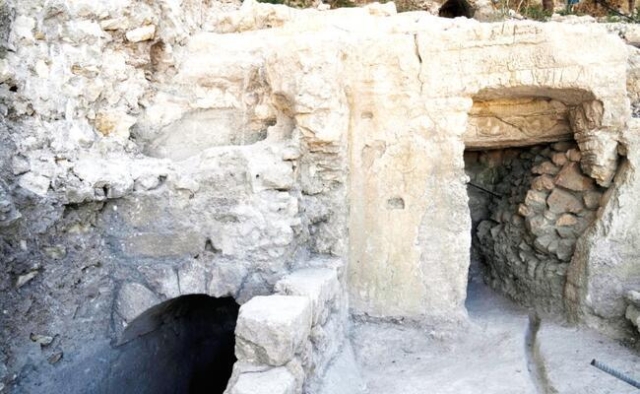Adding to the already vast irrefutable proof of Jewish life in ancient Jerusalem, researchers from the Hebrew University discovered a unique find inside the Jewish quarter of the Old City; in addition to a mikveh, an aqueduct from the Second Temple period, a water pool built by the soldiers of the Roman 10th Legion which Titus tasked to surround the city during the Judean's revolt, as well as a cistern with about 40 cooking pots from the Second Temple period were also found in the excavation.
The mikvah was carved in the rock and covered in a vault that has been preserved intact. Remains of a residential building from the Second Temple period were found next to it. The uniqueness of the mikveh - similar to what was discovered in previous excavations by the Hebrew University of Jerusalem in the Jewish Quarter is on the cliff that separated the Upper City (the luxurious residences of the priests) and The Temple Mount inside the old city of Jerusalem.
#HebrewU archaeologists Michal Haber & Dr. Oren Gutfeld found 2,000 years' of goodies in Jerusalem--a mikveh/ritual bath, bricks stamped by Rome's 10th Legion, and the remains of a villa from the final days before the 2nd Temple’s destruction. More at https://t.co/NfgQStK3N0 pic.twitter.com/x98Mdcf6dS
— Hebrew University (@HebrewU) July 20, 2022
The significance of the find confirmed that there was a caste system in Judea, something Jesus famously rallied against, where not all men were considered equal and where 'priests' became rich on the people's offerings. In addition to the mikvah, other remains were found; according to an impressive teaching fellow from the Institute of Archaeology, Dr. Oren Gutfeld who said that "in the excavations, many remains and findings from the Second Temple, the Roman-Byzantine and the Ottoman periods were discovered. The many ditches, pits, and water pools found in the excavation indicate that in this area, there had been a lot of construction activity related to water supply throughout the generations."
Archaeologists Find an Ancient Mikveh Used by the Jerusalem Elite https://t.co/dijMrgwk4I via @mosaicmag
— Rabbi Wayne Allen (@ravallen) July 22, 2022
Still, the highlight of the excavation is the carved mikvah. Archaeologist Michal Haber explained the importance of the find: "The mikveh was carved under the lower aqueduct, and it seems that was the main source of water for the mikveh, this is something that is unknown to us and requires further research.
"It is known that the elite of the Herodian city lived in this area, so it is an exciting find. Specifically, its proximity to the Temple Mount raises the question of who the residents of that magnificent villa were on the eve of the destruction - could they possibly have been one of the Priestly families?"
In cooperation with the archaeologist of the Jerusalem area for the Antiquities Authority, Dr. Amit Ram, it was decided to preserve the mikveh and the remains of the residential building next to it and integrate them into the construction of the entrance hall of the Western Wall elevator.
Zeev Elkin, Israel’s Minister of Construction and Housing and of Jerusalem Affairs, said the 2000-year-old mikveh, or Jewish ritual bath, “provides proof of a continuous Jewish presence in Jerusalem for millennia.” https://t.co/kfAfPWwyVb
— Algemeiner (@Algemeiner) July 20, 2022
The Minister of Construction and Housing, Jerusalem and Heritage, Ze'ev Elkin, who inaugurated the beginning of the Western Wall elevator just a few weeks ago, said: "The rare finds that were discovered in the excavation area of the Western Wall elevator project are very exciting. The archaeological findings are further evidence of the Jewish presence in Jerusalem for thousands of years. Under my leadership, the Ministry of Jerusalem and Heritage will continue to work to preserve and develop the city's glorious Jewish past while turning the capital into an innovative and progressive city."


